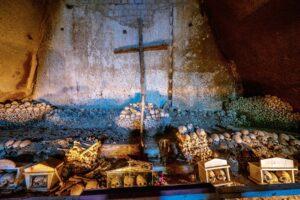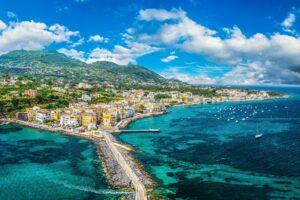Fodor's Expert Review San Domenico Maggiore
One of the Centro Storico's largest churches, this Dominican house of worship was originally constructed by Charles I of Anjou in 1238. Legend has it that a painting of the crucifixion spoke to St. Thomas Aquinas when he was at prayer here. Three centuries later a fire destroyed most of this early structure, and in 1850 a neo-Gothic edifice rose in its place, complete with a nave of awe-inspiring dimensions. In the second chapel on the right (if you enter through the north door) are remnants of the earlier church—14th-century frescoes by Pietro Cavallini, a Roman predecessor of Giotto. Note the depiction of Mary Magdalene dressed in her own hair, and, in front, the crucifixion of Andrew as a devil strangles his judge, the Prefect Aegeas, just below. Along the side are some noted funerary monuments, including those of the Carafa family, whose chapel, to the left of Cosimo Fanzago's 17th-century altar, is a beautiful Renaissance-era set-piece. The San Carlo Borromeo chapel features an... READ MORE
One of the Centro Storico's largest churches, this Dominican house of worship was originally constructed by Charles I of Anjou in 1238. Legend has it that a painting of the crucifixion spoke to St. Thomas Aquinas when he was at prayer here. Three centuries later a fire destroyed most of this early structure, and in 1850 a neo-Gothic edifice rose in its place, complete with a nave of awe-inspiring dimensions. In the second chapel on the right (if you enter through the north door) are remnants of the earlier church—14th-century frescoes by Pietro Cavallini, a Roman predecessor of Giotto. Note the depiction of Mary Magdalene dressed in her own hair, and, in front, the crucifixion of Andrew as a devil strangles his judge, the Prefect Aegeas, just below. Along the side are some noted funerary monuments, including those of the Carafa family, whose chapel, to the left of Cosimo Fanzago's 17th-century altar, is a beautiful Renaissance-era set-piece. The San Carlo Borromeo chapel features an excellent Baptism of Christ (1564), by Marco Pino, a Michelangelo protégé. Other interesting works are the unusual Madonna di Latte, in the Cappella di S. Maria Maddalena, and a beautiful Madonna by Agostino Tesauro in the Cappella San Giovanni. A Ribera painting in the San Bartolomeo chapel depicts the saint's martyrdom. Near the back of the church, looking like a giant gold peacock's tail, is the so-called Machine of 40 Hours, a devotional device for displaying the sacrament for the 40 hours between Christ's burial and resurrection.
Adjacent to the church is its brilliantly restored Dominican monastery, where Saint Thomas Aquinas studied and taught. Virtual photographs outside the Chapter Hall show how the monastery, parts of which date to the 13th century, would have looked before the suppression of monasteries under Napoleon. The hall itself contains a significant fresco of the Crucifixion by the late 17th-century Sicilian painter Michele Ragolia, and the ubiquitous Baroque master Fanzago is responsible for the stuccowork. Note the false windows, a work of optical illusion common to the period.
The standout work in the nearby Grand Refectory is Domenico Vaccaro's Last Supper mural, in which Christ comforts John while Judas, clutching a moneybag, glares at something else. Another mural in the Refectory depicts a famous incident from Saint Thomas Aquinas's life here. Christ is shown directing at Thomas the words, Bravo Tommaso che parlasti bene di me. (Well done, Thomas, for speaking well of me.) Visible in the Refectory are the remains of the stations where the monks would wash their hands before eating, but more recently it served as a law court. Two Camorra bosses—Raffaele Cutolo and Pupetta Maresca—were sentenced here as late as the 1990s.
Also of note are the cloisters, originally for about a hundred monks, now less than five remain. It was here that Thomas Aquinas lived and studied and taught from 1272 to 1274. A magnificent doorway by Marco Bottiglieri marks his cell, now a chapel that can be visited as part of the guided tour.
READ LESS







